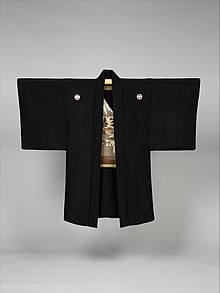

The haori (羽織) is a traditional Japanese jacket worn over a kimono. Resembling a shortened kimono with no overlapping front panels (okumi), the haori typically features a thinner collar than that of a kimono, and is sewn with the addition of two thin, triangular panels at either side seam. The haori is usually tied at the front with two short cords, known as haori himo, which attach to small loops sewn inside the garment.
During the Edo period, economic growth within the wealthy but low-status merchant classes resulted in an excess of disposable income, much of which was spent on clothing. It was during this period that, due to various edicts on dress mandated by the ruling classes, merchant-class Japanese men began to wear haori with plain external designs and lavishly-decorated linings, a trend still seen in men's haori today.
During the early 1800s, geisha in the hanamachi of Fukagawa, Tokyo began to wear haori over their kimono. Haori had until that point only been worn by men; the geisha of Fukagawa, well known for their stylish and unusual fashion choices, set a trend that saw women wearing haori become commonplace by the 1930s. In modern-day Japan, haori are worn by both men and women.
See also
- Hanten, an informal and often padded Japanese jacket
- Happi, a lightweight jacket traditionally worn by shopkeepers or employees as uniform, and commonly worn to festivals in Japan
- Hifu, a sleeveless padded outer vest worn by young children over their kimono to outings and on occasions such as Shichi-Go-San
- Michiyuki, a double-breasted Japanese overcoat characterised by a square neckline and dual fastenings
References
- "MORE JAPANESE HAORI JACKETS & HOW TO TIE A HAORI HIMO". wafuku.wordpress.com. Wafuku. 16 February 2012. Archived from the original on 13 May 2016.
- "History of the Black Haori".
- Dalby, Liza (2000). Geisha (3rd ed.). London: Vintage Random House. pp. 277, 333. ISBN 0-09-928638-6.
External links
- Haori at the University of Michigan Museum of Art
- Haori at the British Museum
- 'Behind the Scenes in Conservation: Japanese Haori' from the Cincinnati Art Museum
- 'On Men's Formalwear' from Ginza Motoji
| Japanese clothing | ||
|---|---|---|
| List of items traditionally worn in Japan | ||
| Traditional |  | |
| Headgear | ||
| Belt / sash | ||
| Footwear | ||
This clothing-related article is a stub. You can help Misplaced Pages by expanding it. |
This article related to the culture of Japan is a stub. You can help Misplaced Pages by expanding it. |